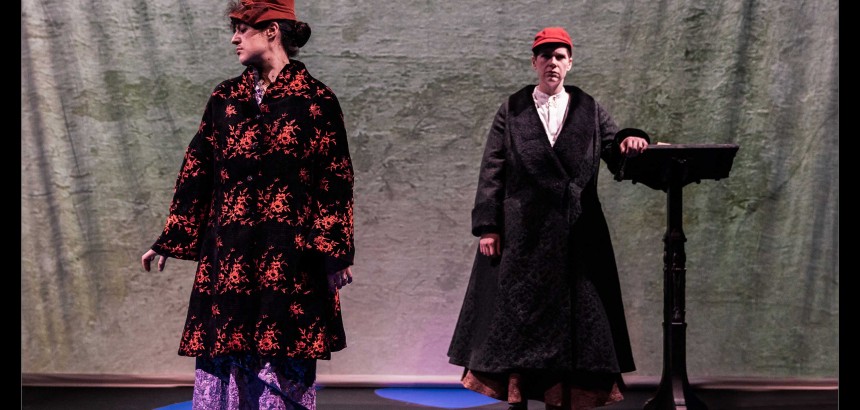My friend Sasha once invited a group of us over to his apartment to read Gertrude Stein’s Tender Buttons from start to finish, the kind of intellectual social exercise that works better in theory than practice. Only knowing Stein by monolithic reputation, Picasso, and Woody Allen, I was surprised to find that I resented the slim book we passed around the room. It didn’t seem like much more to me than artful gibberish.
Within minutes of watching Anna Chatterton, Evalyn Parry, and Karin Randoja’s Gertrude and Alice, I learned just how unoriginal my reaction was to Stein’s words. I wasn’t special or smart for finding (one of) her writings inaccessible—I was yawningly standard.
Parry’s reanimated Stein—socked, sandaled, and Moomin-shaped—acknowledges this moments after removing her jaunty little cap, calling for a show of hands from those who’ve read all her work. Some of her work? A work. Ok, so we haven’t read her. But we know she’s a genius, right? That’s indisputable. We also know about her secretary, the taciturn Alice B. Toklas (Chatterton) who “makes life comfortable” for Stein, who likes to be very comfortable indeed.
Gertrude and Alice is as much about these two fascinating women as it is about how women, at their best, can make life comfortable for one another. Parry and Chatterton are, as usual, seamlessly hilarious and touching in a way that speaks to their mutual understanding as well as Stein and Toklas’s. Such vivid chemistry is a pleasure to witness, with all the small pivots of intimacy exposed under Michelle Ramsay’s warm lighting; a hawk-eyed glance from Chatterton as Parry feigns obliviousness to an unwieldy sideboard is momentous as it is subtle.
Intimacy is what I ended up thinking about during and after. Not just the codified intimacy of a lesbian couple who managed to marry and live through two World Wars. Every time Stein looks meaningfully at Toklas, I also saw Parry looking at Chatterton. Every time either of them addressed the audience, I imagined Karin Randoja, their frequent collaborator and director, somewhere in the house, taking mental notes.
Stein’s genius is the way into their story, but through the wit and tender portrayals of both performers, Stein emerges as a woman who spent most of her life supporting and enabling the genius of others—men, specifically. Whether that was as an advisor to writers like Hemingway and Fitzgerald, or in the purchase of paintings by artists like Matisse, Picasso, and Gaugin, a substantial amount of Stein’s genius was in her gift for patronage. She patronized not simply with money and flattery, but with her deeply expressed comprehension of under-appreciated genius. Stein lived through the success of these men, until her own long-awaited hit, The Autobiography of Alice B. Toklas.
Toklas, Stein’s hirsute, Germanically sibilant lover, sits silently for much of the opening, allowing space for Stein’s expansive genius to fill the stage like a balloon. Gazing into the distance with a benevolent glint in her eye, Parry builds Stein as a pompous, but still charming narcissist, Toklas her number one fan. And, as the story progresses, Stein is observably Toklas’s number one fan as well—from her cooking, to her wisdom, to her valentine-shaped ass.
In Gertrude and Alice, Parry and Chatterton do something altogether odd: they make a performance without dramatic conflict—at least, nothing that threatens the characters or their relationship. Instead, the play feels a bit like a narrative of conflict evaded. Jewish, Europe-dwelling, World War II, women, lesbians. They hid in plain site, and somehow spent nearly 40 years together until Stein’s death in 1946.
Gertrude and Alice, then, is an amendment to an existing story, rather than a visitation by ghosts—it’s a kind of theatrical Genius annotation after the fact. The blue cahier d’école left on each audience member’s chair is a delightful artifact of that, filled as it is with a historical timeline, corrected and expanded be each woman’s hand. Gertrude and Alice doesn’t so much strive to solidify an accurate biography of the women, rather, it’s a piece that emphasizes the story the artists want to tell: a story of love, friendship, and patronage. It’s not revisionist so much as it is lovingly curated.
photo by Jeremy Mimnagh



Fabulously insightful, thank you! I saw it three times and you saw more than I managed…